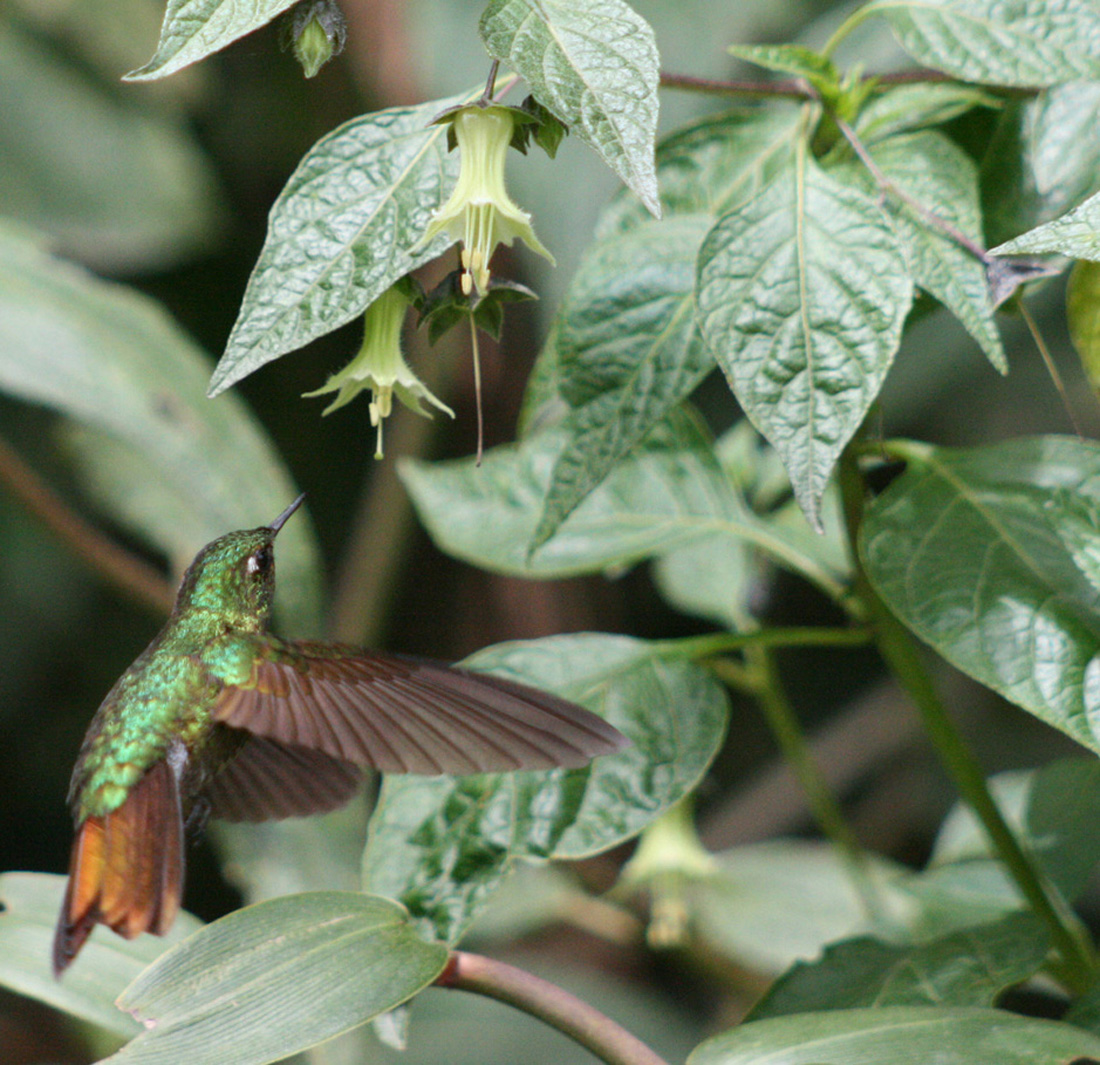
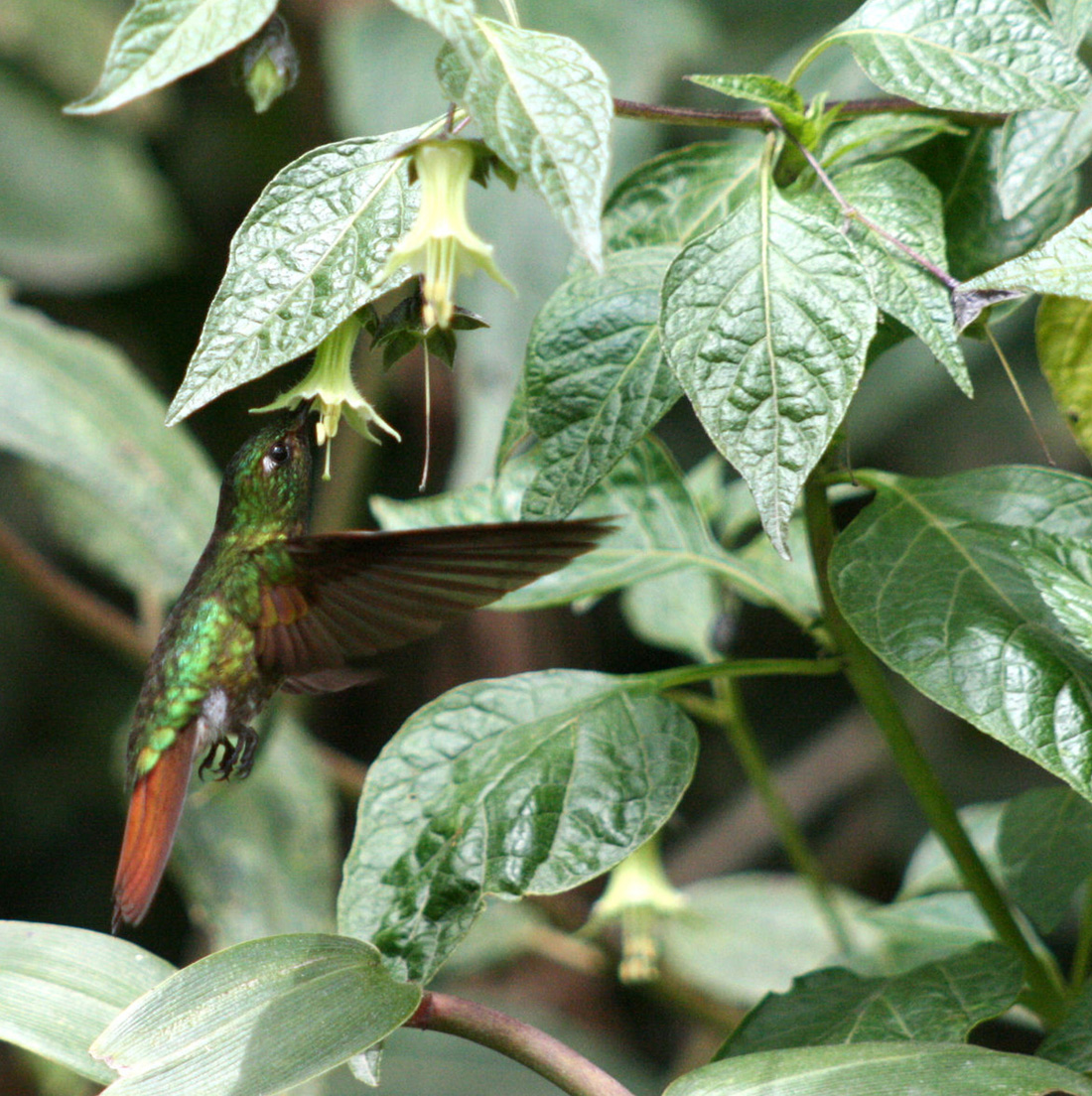
| Jaltomata viridiflora (Humb., Bonpl. & Kunth) M. Nee & Mione | Venezuela, Colombia, Ecuador |
revised 2023 |
Link to Jaltomata homepage |
The information on this page may be cited as a communication with professor Thomas Mione, Central Connecticut State University, Biology Department, Copernicus Hall, 1615 Stanley Street, New Britain, Connecticut 06050-4010, United States of America. | Brittonia 45(2): 138-145. 1993. |
Link to the Jaltomata of Ecuador |
Link to the Jaltomata of Colombia / Venezuela |
Link to local names of Jaltomata species including this one |
Link to chromosome count |
 |
| Figures 1 and 2. Jaltomata viridiflora visited by a rufous-tailed hummingbird. Photo by and generously contributed by Jack Lamb. |
 |
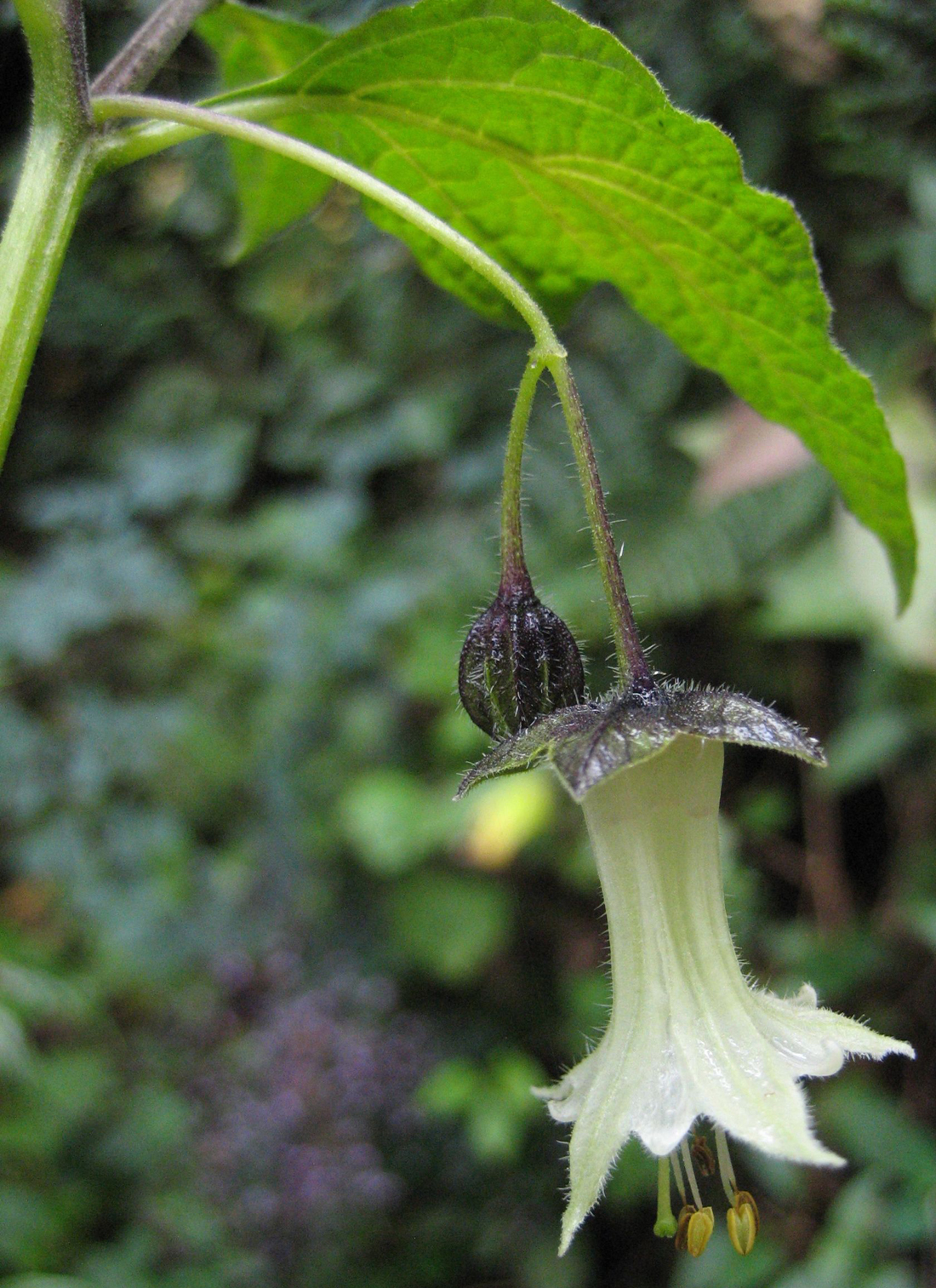 |
| Figure 3, above. Flower of Jaltomata viridiflora. Note that corolla lobes and lobules alternate, totalling 10, and that all anthers have dehisced, and the stigma (green) is to immediate left of the dehisced anthers. Photo by Eric J. Tepe in Ecuador, Tepe 2931 |
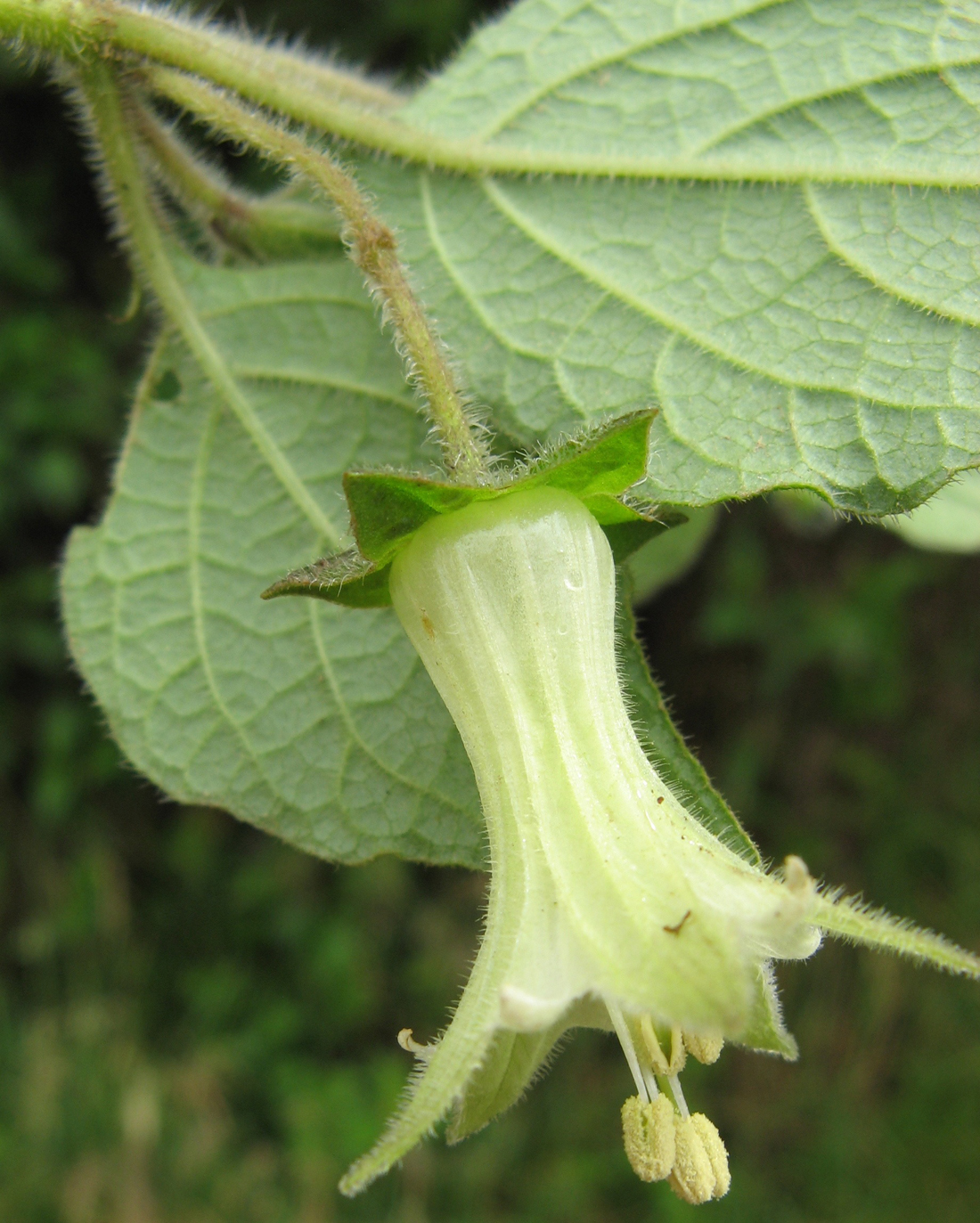 |
| Figure 4, above. Flower of Jaltomata viridiflora. Photo by Stephen Stern in Ecuador, Stern 345 |
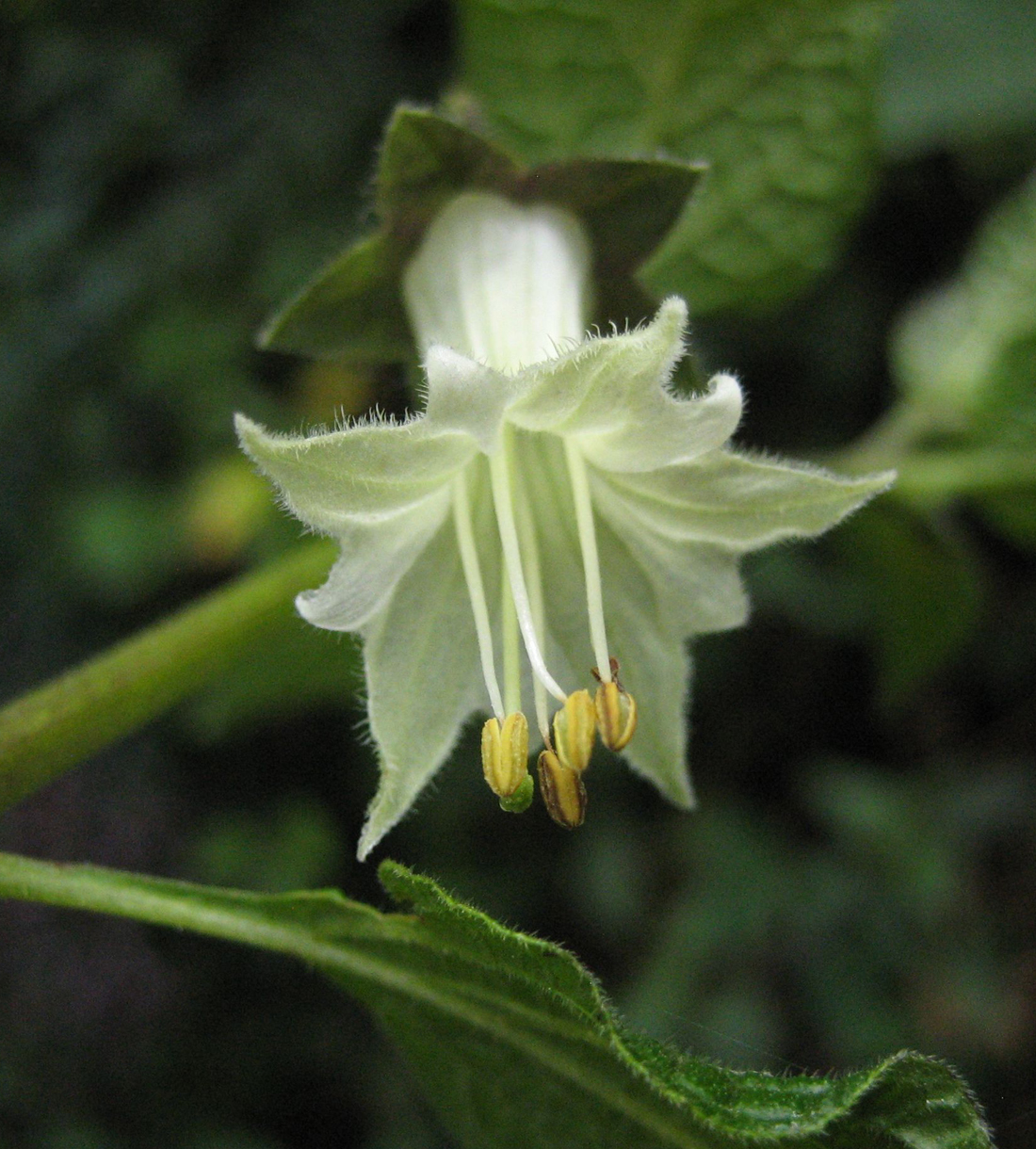 |
| Figure 5, above. Flower (all anthers have dehisced). Photo by Eric J. Tepe in Ecuador, Tepe 2931 |
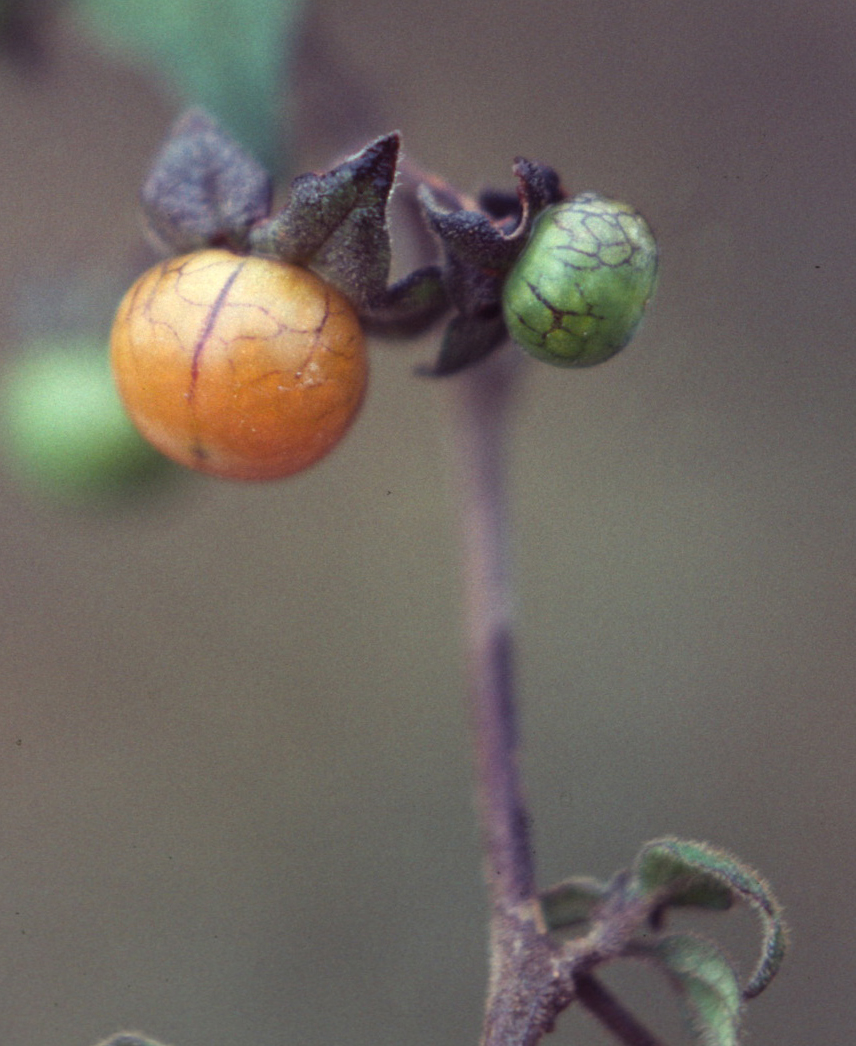 |
Figure 6 Ripe fruits of
Mione |
| Atropa viridiflora Humb., Bonpl. & Kunth, Nov. gen. sp. 3: 11, t. 196. 1818. Type: COLOMBIA. Crescit in convalli Guaitarensi, inter urbem Pasto et Chilanquer, Humboldt & Bonpland 2175 (HOLOTYPE: P!; ISOTYPE: B destroyed, photo of B specimen, F neg. 2531 at GH! and NY!). Hebecladus viridiflorus (H.B.K.) Miers, London J. Bot. 4: 321. 1845. |
| Hebecladus lanceolatus Miers, London J. Bot. 4: 323. 1845. Type: ECUADOR. Hacienda de Pinantura, prope Quito, Hartweg 1301 (HOLOTYPE: K!; ISOTYPE: LD!). |
| Hebecladus mollis Miers, London J. Bot. 7: 352, t . 33. 1848. Type: COLOMBIA. Plages de Combayma, Goudot s.n. (HOLOTYPE: K!). The original illustration is shown below as Figure 14. The seemingly distinctive toothed leaf margin of this holotype was seen on plants also having entire leaves, which are characteristic of the isotype of Atropa viridiflora. |
| Atropa flexuosa may also be a synonym of this species (see Tropicos, http://mobot.mobot.org/cgi-bin/search_vast). |
| Character | Description | Figures on this page |
Habit & Height |
Shrub to 2 m high, sometimes scandent | |
Branches, young |
velutinous to less commonly puberulent with multicellular, uniseriate, unbranched finger hairs, sometimes to mostly gland-tipped | |
older |
||
Leaves, size |
||
| shape | entire to toothed; ovate to ovate-lanceolate, the apex acuminate | |
| hairs | velutinous to less commonly puberulent with multicellular, uniseriate, unbranched finger hairs, sometimes to mostly gland-tipped | |
| petiole | ||
Inflorescence |
1- 4 flowered | |
peduncle |
to 4.4 cm, puberulent to somewhat densely hairy, the hairs finger shaped and probably gland-tipped |
3, 4 |
pedicel |
to 1.2 cm, sparsely hairy to velutinous, the hairs finger-shaped, and at least some seem gland-tipped |
3, 4, 8, 10 |
Calyx at flowering |
green to purple | 1, 3, 4 |
| shape / position when flowering | rotate, sometimes very broadly concave approaching rotate |
1,2,3,4 |
| at fruit maturity | 10 | |
Corolla color |
pale-green, less commonly white or pale yellow | 1,2,3,4,5 |
shape and size |
urceolate-tubular, the tube 9.5 - 20 mm long, the base of the tube 9 mm (perpendicular to tube length), the limb planar, 1.2 to 2.0 cm across depending on how the flower was pressed (measurements made on pressed specimens) | 1,2,3,4,5 |
lobes / lobules |
10 total: the five larger lobes alternate with five smaller lobules, all flaring (not recurved) | 1,2,3,4,5 |
hairs
|
||
Stamen length including anther |
17 - 26 mm | |
| length stamens exserted beyond distal end of corolla (applicable if corolla has a well-defined tube) | 0 - 8 mm the stamens elongating after the flower opens |
|
| seems to be no | I carefull rehydrated and then dissected a flower of Spooner 5020 and I can't see radial thickenings. | |
| base expanded laterally? | yes | 16 |
| filaments | glabrous | |
| anther color | yellow | |
| anther size | 1.7 - 2.2 mm | |
| anther mucronate/mucronulate | no | Spooner et al. 5020 |
| insertion of filament into anther | into bottom of anther however more of distal end of filament shows in ventral view than in dorsal view | 11 |
| anthers of a flower open simultaneously? | ||
| pollen quantity per flower | ||
| pollen grain size | ||
| corona | no | |
Stigma |
shallowly bilobed | Spooner et al. 5020 |
Style |
||
Ovary |
||
Ovules per ovary |
||
Nectar |
translucent | |
| Herkogamy | Stigma and anthers sometimes differing in height by up to 5 mm, either may be exserted. | |
| Protogyny | ||
Fruit color (at maturity) and size |
orange, 13-19 mm diam., 10-12 mm high Fruits not eaten (Hawkes 422, Mione 458). |
"reddish" on Fosberg 20426 |
Seeds per fruit |
||
Seed Size |
||
Chromosome number |
n = 12 | Heiser, 1963 |
Growability in Connecticut, USA |
||
How long does it take from flower to ripe fruit? |
||
Self-Compatible? |
||
Seed Germination |
||
Ratio of pollen to ovules |
||
| Character | Description of Jaltomata viridiflora | Figures on this web page |
The photos shown in Sagástegui A. et al. (2003, page 229) are labeled as J. viridiflora but are actually J. incahuasina.
Distribution & Habitat: Andes of Western Venezuela through Ecuador, 2,500-3,400 m. Subparamo and disturbed habitats.
| Locality | altitude m | habitat | collector & number | date of collection | data entry | |
|---|---|---|---|---|---|---|
| Táchira | 35.2 km E of Plaza Bólivar of town of La Grita, on rd to Pregonero | 2,740 | no data | D. M. Spooner, A. Vargas, G. Rivero 6320 (WIS) | 30 Aug 1992 | Nov 2018 |
| Mérida | trail leading from La Negrita to the Boquerón of the Quebrada de las Cañas | 2,990-3,300 |
Páramo dominated by Espeletia shultzii | J. L. Luteyn et al. 6122 (NY, US) | 31 Oct 1978 | Sep 2010 |
| Mérida | 3 km E of Piñango on rd to Timotes | 2,700 | sunny area along stream | D. M. Spooner, A. Vargas, G. Rivero 6338 (WIS) | 7 Sep 1992 | Nov 2018 |
| Province | Locality | altitude m | habitat | collector & number | date of collection | data entry |
|---|---|---|---|---|---|---|
| Imbabura | 0°12'53.0'' N, 78°20'58.1'' W | 3125 |
no data |
E.J. Tepe et al. 3066 | 27 Feb 2011 | Sep 2011 |
| Pichincha | Cantón: Quito. Parroquia: Nono. Reserva Yanacocha (Fundanción de Conservación Jocotoco). 0 7' 0" S, 78 35' 10" W | 3500 |
montane cloud forest | J. L. Clark et al. 7340 | 11 Mar 2003 | Sep 2010 |
| Pichincha | Above the NW part of Quito on road to Nono, Santa Isabel-Cotocollao, 0 06' 17" S, 78 31' 30" W | 3250 | steep roadside bank | L. Bohs et al. 3142 (UT) | 4 Mar 2003 | Nov 2016 |
| Napo | 0°22'24.5'' S, 78°09'59.9'' W | 3350-3450 |
no data |
E.J. Tepe et al. 2931 | 10 Feb 2011 | Sep 2011 |
| Tungurahua | Road between El Triunfo and Patate, 1 18'54" S, 78 24'47" W | 2600 | roadside bank | L. Bohs et al. 3128 (UT) | 26 Feb 2003 | Nov 2016 |
| Department | Locality | altitude m | habitat | collector & number | date of collection | data entry |
|---|---|---|---|---|---|---|
| Antioquia | Municipio de Caldas, Vereda La Corrala | 2440 | al lado del camino, bosque húmedo | S. Morales & J. R. Giraldo J. 5880 (NY) | 7 Oct 1985 | Jun 2023 |
| Departamento del Valle | Cordillera Occidental, Los Farallones, extremo N, vertiente oriental, entre Alto del Buey y Las Cascadas | 3250 - 3050 |
bosques | J. Cuatrecasas 18103 (US) | 13 Oct 1944 | Aug 2010 |
| Cundinamarca | Western slope of the Cordillera, Vereda de San Antonio on the road to La Mesa | 2600 |
forest | J. Cuatrecasas 26729 (US) | 26 Jan 1965 | Aug 2010 |
| Cundinamarca | Cordillera Oriental, Vertiente Oriental. Entre Une y Fosca | 3000-3200 |
no data | H. García-Barriga & R. Jaramillo M. 20514 | 14 Feb 1974 | Sep 2010 |
| Nariño | Llano Grande, W of Ipiales, near Lago Cumbal | 3250 | in grassland on slope | R. Castillo, R. Pineda, L. López & D. M. Spooner 1218 | 8 July 1992 | Jan 2013 |
Old Method of Listing Specimens, to be converted to table above:
Venezuela . MÉRIDA: Rangel, Parte baja de la cañada de La Mucuchache, la quebrada homónima, afluente del río Chama, 3,400-3,300 m, L. Ruíz-Terán & M. Lopez-Figueiras 287 (MERF);
ECUADOR.
AZUAY:
Nudo de Portete, pass between headwaters of the ríos Tarqui and Giron, 2,744 m, W. H. Camp E-2181 (NY);
CARCHI: common along Tulcán-El Carmelo road, 3,290 m, T. Mione & C. McQueen 458 & 459 (CONN), and direct (dirt) road between Tulcán and El Angel, 3,300 m, 460 (CONN);
Tulcán-Pun road bank, 3,260 m, Y. Mexia 7586 (K);
COTOPAXI: 12.7 km from gasoline station at N end of Pilalo, on rd to La Mana, 3,180 m, D. Spooner et al. 5091 (herbarium of T. Mione);
PICHINCHA: declive oriental del Volcán Pichincha, near summit of Cruz Loma, 3,400 m, J. A. Steyermark 52383 (NY);
NAPO: 10 km E of Papallacta on road to Baeza, 2,850 m, L. Holm-Nielsen et al. 6814 (NY);
CHIBORAZO-CAÑAR BORDER: Between Sta. Rosa and Joyagshi, 2,637 m, W. H. Camp E-4014 (NY).
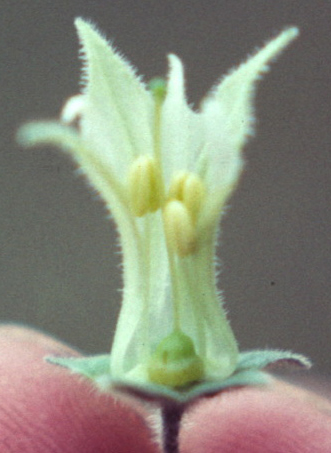 |
Figure 7. I longitudinally ripped away part of the corolla. |
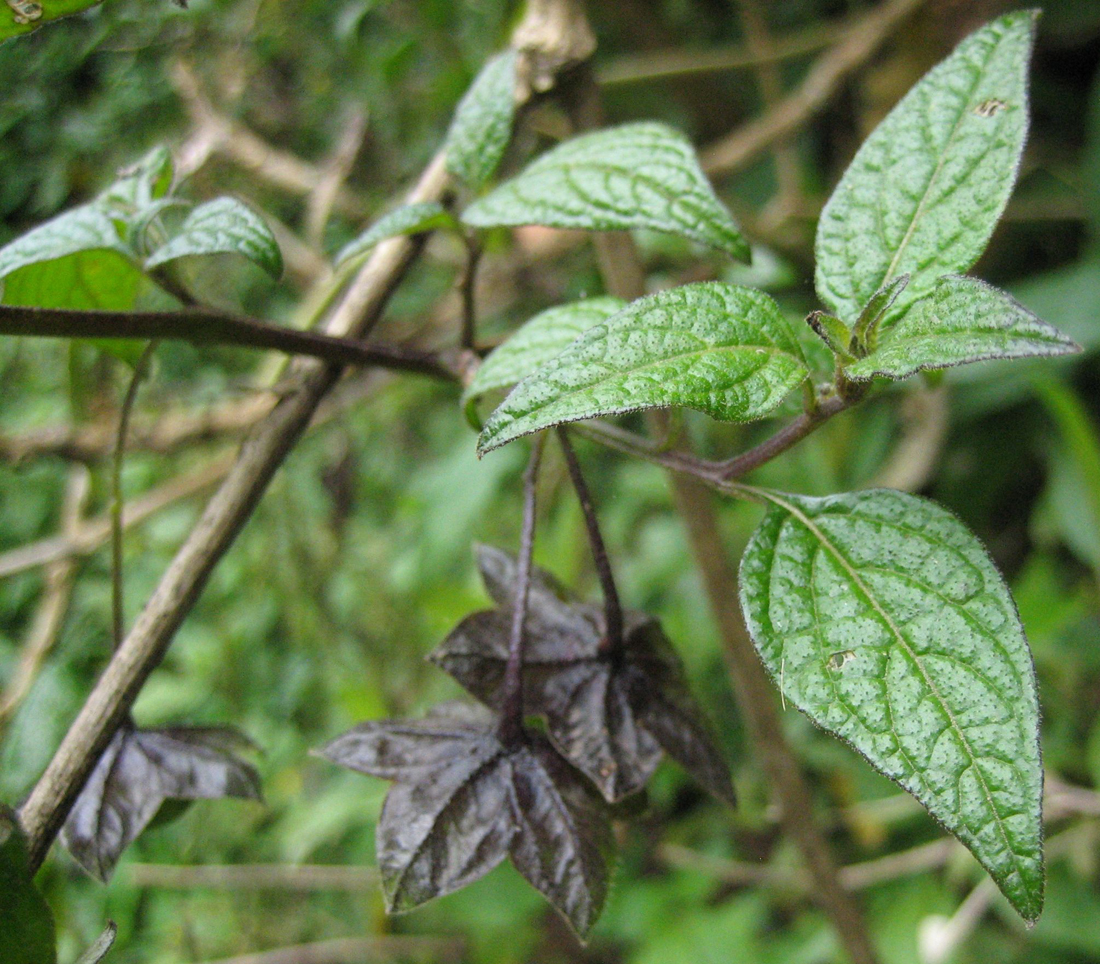 |
| Figure 8, above. Abaxial face of calyx (purple), and leaves. Photo by Eric J. Tepe in Ecuador, Tepe 2931 |
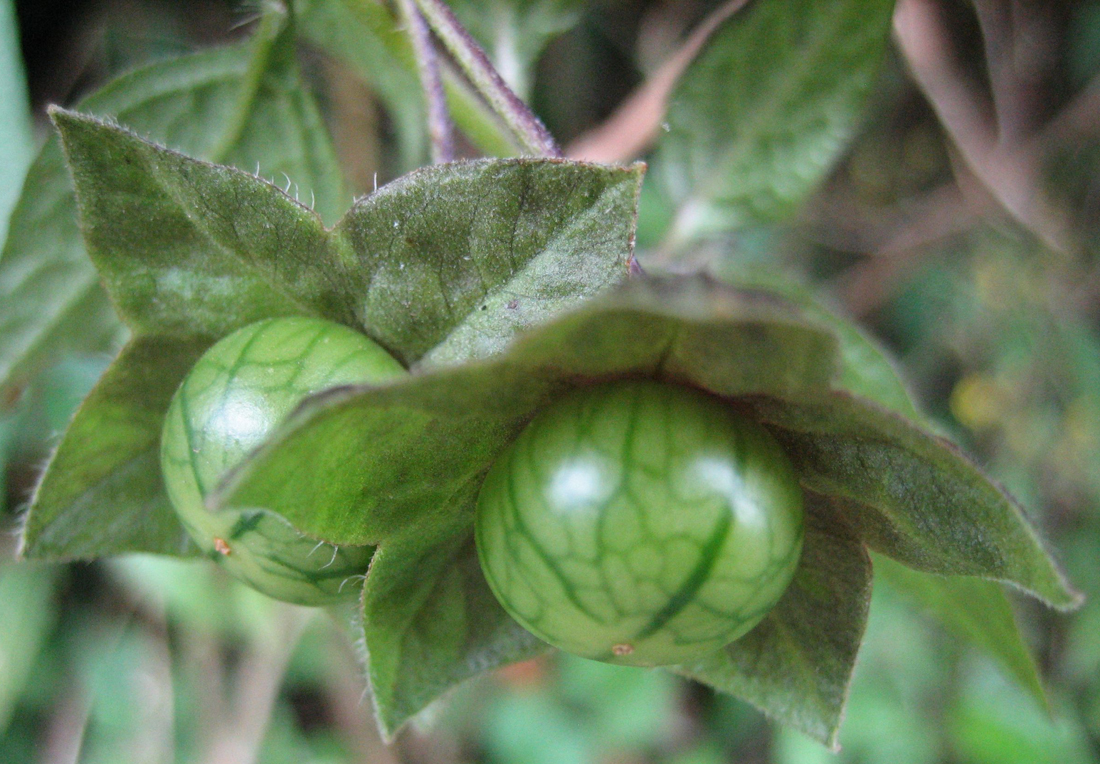 |
| Figure 9, above. Unripe fruits. Photo by Eric J. Tepe in Ecuador, Tepe 2931 |
| Figure 10. Pressed calyx, abaxial face, probably at fruit maturity, Jaltomata viridiflora, vertical units in upper right are mm, R. Castillo, R. Pineda, L. López & D. M. Spooner 1218, photo by Thomas Mione. | Figure 11. Anthers of Jaltomata viridiflora, ventral view on left, dorsal view on right. Flower from a pressed specimen was rehydrated (anthers are yellow normally). Units along bottom are mm. Spooner et al. 5020, photo by Thomas Mione. |
| Figure 12. Jaltomata viridiflora. This plant is in the moist forest along the dirt road at the back side of Laguna Papallacta, ca. 3200m, without collection number because collection permits didn't extend to Napo. Photo by Stacey D. Smith. |
| Figure 13. Jaltomata viridiflora. This plant is in the moist forest along the dirt road at the back side of Laguna Papallacta, ca. 3200 m, without collection number because collection permits didn't extend to Napo. Photo by Stacey D. Smith. |
| Figure 14. Jaltomata viridiflora. This plant is in the moist forest along the dirt road at the back side of Laguna Papallacta, ca. 3200 m, without collection number because collection permits didn't extend to Napo. Photo by Stacey D. Smith. |
| Figure 15, above. | Figure 16, above. |
| Figure 17, above. Photo of the Paris (type) specimen of Jaltomata viridiflora, photo by T. M. taken in April of 2004 | Figure 18. isotype (LD) of Hebecladus lanceolatus Miers, photo by T. M. taken December 2004. |
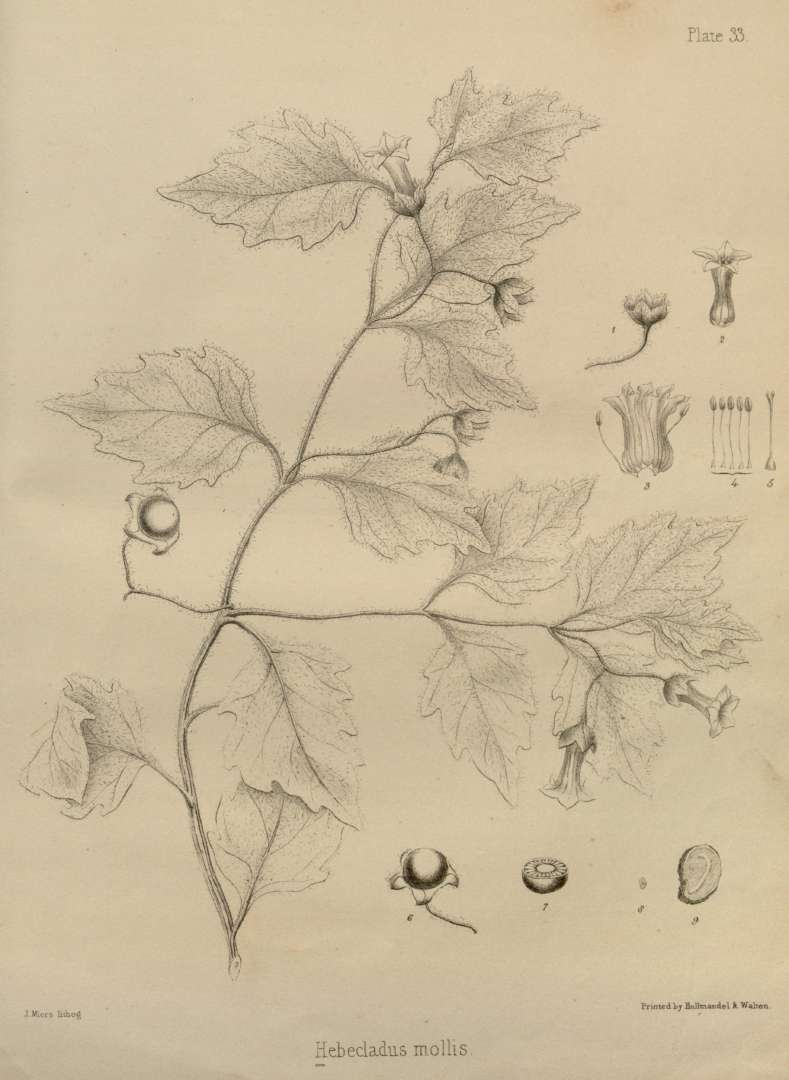 |
Figure 19. Hebecladus mollis is a |
| Seeds stored in the refrigerator for years and then planted on moist potting mix showed the first above-ground signs of germination 15 and 16 days after being sown. A plug-in germination mat (warm) was under the cups in which the seeds were sown. Seeds of collection Mione 458 were collected 28 December 1989, sown 12 April 2007 with first germination 28 April 2007. Seeds of collection Mione 460 were collected 29 December 1989, sown on 12 April 2007 with first germination on 27 April 2007. |
Link to Jaltomata homepage |
The information on this page may be cited as a communication with professor Thomas Mione, Central Connecticut State University, Biology Department, Copernicus Hall, 1615 Stanley Street, New Britain, Connecticut 06050-4010, United States of America. |